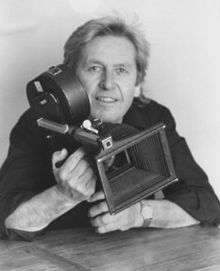Gary Graver
| Gary Graver | |
|---|---|
 | |
| Born |
July 20, 1938 Portland, Oregon, U.S. |
| Died |
November 16, 2006 (aged 68) Rancho Mirage, California, U.S. |
| Occupation | Director, cinematographer |
| Spouse(s) | Jillian Kesner-Graver |
Gary Graver (July 20, 1938 – November 16, 2006) was an American film director and cinematographer. He was a prolific film-maker but is best known as Orson Welles' final cinematographer. Under the pseudonym of Robert McCallum he also directed adult films.
Graver was born and raised in Portland, Oregon. In high school, he produced and starred in his own radio show, and had built a movie theatre in his parents' basement where he showed his own films. At age 20, he moved to Hollywood to become an actor, but drifted into production when work as an actor was scarce. He was drafted into the U.S. military and was assigned to the Navy Combat Camera Group. After returning to civilian life, Graver made documentaries for a year before starting to work on larger budget features.
In 1970, Graver made an unannounced call on Orson Welles, saying he wanted to work with the director. Welles told Graver that only one other person had ever called him to say they wanted to work with him - and that was Gregg Toland who worked with Welles on Citizen Kane.[1]
"From that day forward, Orson Welles was the central figure in Gary Graver's life: more important than his wife, his children, his bank account, and his health. For the rest of Orson's life (and his own) Graver belonged to the great director." [1]
Soon after, Welles and Graver started work on the unfinished film The Other Side of the Wind, in addition to other projects Welles had in the works including F For Fake (1973) and Filming Othello (1978).
Graver's work for Welles was unpaid, and during the shooting of one scene in The Other Side of the Wind, Welles used as a prop his 1941 Oscar that he won as the co-writer of Citizen Kane. When shooting was finished, he handed the statuette to Graver saying, "Here, keep this." Graver understood this to be a gift in lieu of payment for his work. Graver held onto the award for several years until he ran into financial trouble in the 1990s, and in 1994 he sold it for $50,000. The purchaser, a company called Bay Holdings, then attempted to sell it at auction through Sotheby's in London. When Welles' daughter, Beatrice Welles learned of the intended sale, she successfully sued both Graver and the holding company to stop the sale. She eventually took possession of the statuette before then selling it on herself.[2]
Besides his work with Welles, Graver also worked for other Hollywood directors including Roger Corman, Fred Olen Ray and Ron Howard. The bulk of his output was B-movies since, as he put it, "I knew how to make a movie without much money."[3]
Graver's work in the adult film industry resulted in more than 135 films including Unthinkable, which won the AVN Award for Best All-Sex Video in 1985. Graver was later inducted into the AVN Hall of Fame for his work.[4]
Death
Graver died on November 16, 2006 at his home in Rancho Mirage, California after a lengthy battle with cancer. His widow, former actress Jillian Kesner died the following year of complications of a staph infection, which she contracted after having been diagnosed with leukemia. She was 58 years old.[5][6] Graver's memoir, Making Movies with Orson Welles, co-written by Andrew J. Rausch, was published by Scarecrow Press in 2008.
References
- 1 2 Karp, Josh (May, 2015) "Orson's Last Stand" Vanity Fair, pages 143-151; 168-171
- ↑ Dave Kehr, " Objection Quashes Sale of Welles's 'Kane' Oscar", New York Times, July 22, 2003
- ↑ "Gary Graver, 68; maverick cinematographer tried to complete Orson Welles' final film". The Los Angeles Times. Retrieved 2012-01-05.
- ↑ Giving Gary Graver His Due, avn.com; accessed August 4, 2015.
- ↑ "Jillian Kesner-Graves obituary". Jilliankesner.com. Retrieved 2010-10-07.
- ↑ "Wellesnet". Wellesnet. 2007-12-08. Retrieved 2010-10-07.
External links
- Official homepage
- Gary Graver at the Internet Movie Database
- Los Angeles Times obituary
- Gary Graver Profile
- Gary Graver at AllMovie
- Gary Graver at Wellesnet
- Unhappy with the way he felt producers sometimes butchered his work, in 2004 Graver made a documentary outlining his grievances. The entire documentary was posted on YouTube in several parts: A Gary Graver Movie on YouTube.